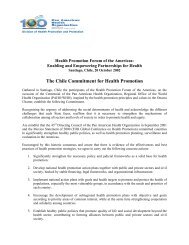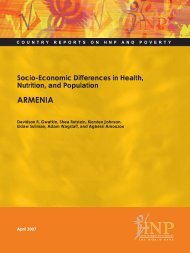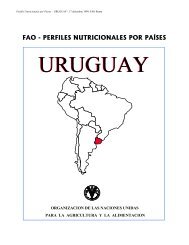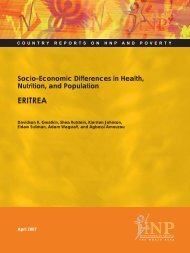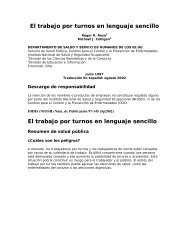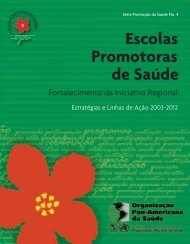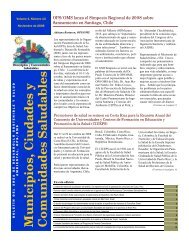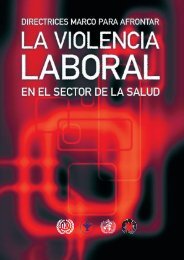Guidelines for drinking-water quality. Volume 1 - BVSDE
Guidelines for drinking-water quality. Volume 1 - BVSDE
Guidelines for drinking-water quality. Volume 1 - BVSDE
You also want an ePaper? Increase the reach of your titles
YUMPU automatically turns print PDFs into web optimized ePapers that Google loves.
derivation of TDIs used in developing guideline values <strong>for</strong> <strong>drinking</strong>-<strong>water</strong> <strong>quality</strong>.<br />
ADIs are established <strong>for</strong> food additives and pesticide residues that occur in food <strong>for</strong> necessary<br />
technological purposes or plant protection reasons. For chemical contaminants, which usually<br />
have no intended function in <strong>drinking</strong>-<strong>water</strong>, the term “tolerable daily intake” is seen as more<br />
appropriate than “acceptable daily intake,” as it signifies permissibility rather than acceptability.<br />
As TDIs are regarded as representing a tolerable intake <strong>for</strong> a lifetime, they are not so precise that<br />
they cannot be exceeded <strong>for</strong> short periods of time. Short-term exposure to levels exceeding the<br />
TDI is not a cause <strong>for</strong> concern, provided the individual’s intake averaged over longer periods of<br />
time does not appreciably exceed the level set. The large uncertainty factors generally involved in<br />
establishing a TDI (see below) serve to provide assurance that exposure exceeding the TDI <strong>for</strong><br />
short periods is unlikely to have any deleterious effects upon health. However, consideration<br />
should be given to any potential acute toxic effects that may occur if the TDI is substantially<br />
exceeded <strong>for</strong> short periods of time.<br />
The calculated TDI was used to derive the guideline value, which was then rounded to one<br />
significant figure. In some instances, ADI values with only one significant figure set by JECFA or<br />
JMPR were used to calculated the guideline value. The guideline value was generally rounded to<br />
one significant figure to reflect the uncertainty in animal toxicity data and exposure assumptions<br />
made. More than one significant figure was used <strong>for</strong> guideline values only where extensive<br />
in<strong>for</strong>mation on toxicity and exposure to humans provided greater certainty.<br />
No-observed-adverse-effect level and lowest-observed-adverse-effect level<br />
The NOAEL is defined as the highest dose or concentration of a chemical in a single study, found<br />
by experiment or observation, that causes no detectable adverse health effect. Whenever<br />
possible, the NOAEL is based on long-term studies, preferably of ingestion in <strong>drinking</strong>-<strong>water</strong>.<br />
However, NOAELs obtained from short-term studies and studies using other sources of exposure<br />
(e.g., food, air) may also be used.<br />
If a NOAEL is not available, a LOAEL may be used, which is the lowest observed dose or<br />
concentration of a substance at which there is a detectable adverse health effect. When a LOAEL<br />
is used instead of a NOAEL, an additional uncertainty factor is normally used (see below).<br />
Uncertainty factors<br />
The application of uncertainty factors has been widely used in the derivation of ADIs <strong>for</strong> food<br />
additives, pesticides, and environmental contaminants. The derivation of these factors requires<br />
expert judgement and a careful sifting of the available scientific evidence.<br />
In the derivation of the WHO <strong>drinking</strong>-<strong>water</strong> <strong>quality</strong> guideline values, uncertainty factors were<br />
applied to the lowest NOAEL or LOAEL <strong>for</strong> the response considered to be the most biologically<br />
significant and were determined by consensus among a group of experts using the approach<br />
outlined below:<br />
Source of uncertainty<br />
Factor<br />
Interspecies variation (animals to humans) 1-10<br />
Intraspecies variation (individual variations) 1-10<br />
Adequacy of studies or database 1-10<br />
Nature and severity of effect 1-10<br />
Inadequate studies or databases include those that used a LOAEL instead of a NOAEL and<br />
studies considered to be shorter in duration than desirable. Situations in which the nature or<br />
severity of effect might warrant an additional uncertainty factor include studies in which the endpoint<br />
was mal<strong>for</strong>mation of a fetus or in which the end-point determining the NOAEL was directly




